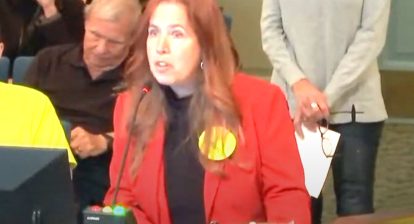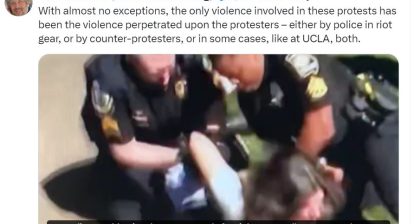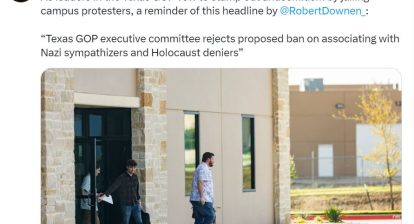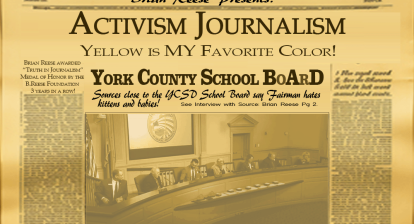Location: York County, VA
Author: Brian Reese, Digital Producer, WAVY.com news organization
Date: May 28, 2024
Time: 3:15 PM, Updated at 5:55 PM
Title: York County School Board removes controversial right-wing board chair
References to Previous Reese articles:
- York School Board vice chair’s comments on slaves highlight history of incendiary rhetoric online
- ‘Teachers are fearful’: York County teacher accused of harassment by school board member speaks out
- Dozens speak out over concerns with new York County School Board leadership
- ‘Trainwreck’: New school board leadership in York County accused of militia ties, could face legal issues
- Dozens speak out over concerns with new York County School Board leadership
- York County School Board won’t get policy services from right wing group
Brian Reese Intent and Bias: Brian Reese appears intent on presenting a hostile and biased viewpoint against what he terms as the “right-wing” members of the York County School Board. The article is structured to highlight controversies and criticisms associated the School Board that brands members as “right-wing”, particularly Lynda Fairman, while subtly endorsing the changes in leadership as what he views is a positive development.
Brian Reese is again adding to his own ecosystem of “truth” where he consistently provides references to his previous articles in highlighted callouts scattered throughout to reinforce and amplify negative connotations of Lynda Fairman. By constantly referencing his previous articles, he is generating his ecosystem of “truth” that is one-sided, biased, and is not representative of the total story. It has been demonstrated in the past the analyses of these articles, that most of his “facts” are suppositions embellished with inflammatory rhetoric that have a political or social agenda threads back through his liberal outlook on conservative values. His use of extreme left-wing sources to quote and draw from and heavily profile in his articles, compromises any journalistic integrity that is relevant to any topic that he writes about that is associated with the York County School Board.
Below is a detailed analysis of this Brian Reese article, with further analysis of Brian Reese’s character assassination of Lynda Fairman.
Use of Loaded Language
- Title: The phrase “controversial right-wing board chair” immediately sets a negative tone. The word “controversial” implies disapproval, while “right-wing” polarizes the subject.
- First Paragraph: The term “controversial right-wing board chair” is repeated, reinforcing the negative connotation.
- Description of Actions: “Culture of fear and intimidation,” “poor communication,” “dubious, and potentially illegal, actions,” and “retaliation tactics” are strong, unverified accusations against Lynda Fairman, painting her in a consistently negative light. This language suggests a predetermined judgment about Fairman’s leadership and political stance.
Selective Highlighting of Criticism
- Fairman Criticism: The article mentions multiple allegations against Fairman, including creating a “culture of fear and intimidation” and engaging in “potentially illegal” actions, without providing concrete examples or evidence.
- Goodwin’s Past Criticism: While acknowledging that Goodwin faced criticism, the article is vague about the specifics of the criticism, focusing instead on her statements of moving forward and improving relationships.
Imbalanced Presentation of Board Members
- Lynda Fairman:
- Described with negative terms and accusations.
- No comment after the vote, leaving her without a voice in the narrative.
- Fairman is described as creating a “culture of fear and intimidation” and engaging in “potentially illegal actions,” including “alleged retaliation tactics against Superintendent Victor Shandor.”
- These accusations are presented without any quotes or detailed evidence from multiple sources, which could indicate an attempt to paint Fairman in a particularly negative light.
- Kimberly Goodwin:
- Initially described as part of the “right-wing majority,” but later portrayed positively as someone making “hard decisions” for the good of students.
- Goodwin’s difficult decision to remove Fairman is highlighted, portraying her as a responsible and thoughtful leader: “Goodwin said it was a hard decision for her to make.”
- Goodwin is quoted extensively, emphasizing her commitment to the students and the community: “my goal is to restore trust and strengthen relationships within our community by listening to and addressing your concerns.”
- Goodwin was given space to share her written statement, emphasizing her goals and positive outlook.
- James Richardson:
- Portrayed as an “outspoken critic” of Fairman, indicating alignment with the article’s negative portrayal of her.
- Provided a platform to express his support for Goodwin and his vision for the board.
Selective Omission and Speculation
- Potential Litigation: The article mentions potential litigation from Superintendent Shandor against the board but provides no details, leaving readers to speculate on the severity and implications.
- Future Speculation: The article speculates that Goodwin might join Fairman in future controversial measures, despite recent oppositional votes, implying ongoing potential for negative actions.
Examples of Bias and One-sided Viewpoints
- Richardson and Shandor’s Support:
- Positive statements from James Richardson and Superintendent Victor Shandor about Goodwin and Richardson’s intentions are included, adding to the favorable depiction of the new leadership.
- Richardson’s quote emphasizes collaboration and moving forward: “I look forward to working closely with our new chair and to helping her grow and succeed in this role as we move forward.”
- Board Actions and Votes:
- The 3-2 vote to remove Fairman and the 4-1 vote to appoint Goodwin are framed in a way that emphasizes division and controversy.
- The focus on dissenting votes (Fairman and Pajevic voting no) highlights conflict rather than consensus.
- Quotes and Statements:
- Positive statements from Goodwin, Richardson, and Shandor are prominently featured, while Fairman is given no platform for rebuttal or defense.
- Goodwin’s written statement is quoted at length, presenting her as a unifying figure, whereas Fairman is left without a counter-narrative.
Intent to Provide a Hostile Viewpoint
- Narrative Structure: The article begins and ends with a focus on conflict and controversy, bookending the story with a negative portrayal of Fairman and the right-wing majority.
- Lack of Balance: No efforts are made to present Fairman or her supporters’ perspectives, resulting in a one-sided narrative that lacks balance and fairness.
In summary, the article demonstrates several characteristics of hit piece journalism, including the use of loaded language, selective highlighting of criticism, imbalanced presentation of board members, and speculative assertions. The article employs several techniques to present a hostile and biased viewpoint against the right-wing members of the York County School Board, particularly Lynda Fairman. The overall intent appears to be to portray Fairman and her allies negatively while casting Goodwin and her supporters in a more favorable light. This analysis highlights Brian Reese’s intent to influence the reader’s perception of the board’s leadership changes.
Character Assassination of Lynda Fairman
The article contains several elements that contribute to the character assassination of Lynda Fairman, portraying her in a negative light and undermining her credibility as a board chair. Here are the key points and tactics that Brian Reese used:
- Labeling and Negative Framing:
- “Controversial right-wing board chair”: The title alone sets a negative tone by labeling Fairman as “controversial” and aligning her with the “right-wing,” which can carry negative connotations depending on the reader’s perspective.
- Highlighting Allegations and Criticisms:
- “Culture of fear and intimidation”: The article accuses Fairman of creating a hostile environment for teachers and staff, a serious allegation that damages her reputation without providing concrete evidence or specific examples.
- “Poor communication and dubious, and potentially illegal, actions”: These phrases suggest misconduct and legal issues, casting doubt on her integrity and competence.
- Lack of Balance in Reporting:
- Absence of Fairman’s Perspective: Fairman is not given a chance to defend herself or provide her side of the story. The article mentions she had “no comment” after the vote, which further isolates her without explaining her perspective.
- Selective Criticism: While Fairman is heavily criticized, the article does not delve into the criticisms faced by other board members, such as Goodwin, in a similar manner. This selective approach highlights Fairman’s negative aspects disproportionately.
- Associating with Controversial Actions:
- “Alleged retaliation tactics against Superintendent Victor Shandor”: By including this unsubstantiated claim, the article links Fairman with unethical behavior, enhancing the negative portrayal.
- Leadership Issues: The article suggests that the board had to meet in a closed session to discuss potential litigation involving Fairman, implying serious governance issues.
- Irony and Sarcasm:
- “Ironically”: The use of irony when mentioning that Goodwin made the motion to remove Fairman subtly mocks the situation, suggesting hypocrisy or unexpected behavior among the board members.
- Speculative Future Controversies:
- Potential for future contentious actions: The article speculates that Fairman and Goodwin might still push through controversial measures like “book bans,” keeping the reader suspicious of Fairman’s influence even after her removal as chair.
- Unsubstantiated Claims:
- “Pattern of poor communication”: This broad claim is presented without specific incidents or testimonies to back it up, which can be seen as an attempt to further tarnish Fairman’s image without substantial evidence.
Examples from the Article:
- “Lynda Fairman was removed as chair in a 3-2 vote Tuesday afternoon in a special meeting at York Hall. Fairman and board member Zoran Pajevic voted no.”
- Contextualizes her removal as a notable event, emphasizing the division within the board.
- “Fairman has made up the new three-member right-wing majority that was voted in this past November.”
- Links Fairman to a specific political faction, which can polarize readers.
- “She was accused of creating a culture of fear and intimidation for teachers and staff, a pattern of poor communication and dubious, and potentially illegal, actions as chair, including alleged retaliation tactics against Superintendent Victor Shandor.”
- This sweeping statement consolidates multiple negative allegations into a single, damning portrayal.
- “Before Tuesday’s open special meeting, the board met for nearly an hour in closed session to discuss potential litigation from the superintendent against the board.”
- Implies serious governance issues and legal troubles associated with Fairman’s leadership.
- “Fairman had no comment after Tuesday’s vote.”
- The lack of comment leaves her without a voice in the article, further alienating her from the reader.
Brian Reese employs various tactics to assassinate Lynda Fairman’s character, including negative labeling, highlighting unsubstantiated allegations, lack of balanced reporting, and speculative future controversies. These methods collectively aim to damage her reputation and portray her as an unfit leader within the York County School Board.














